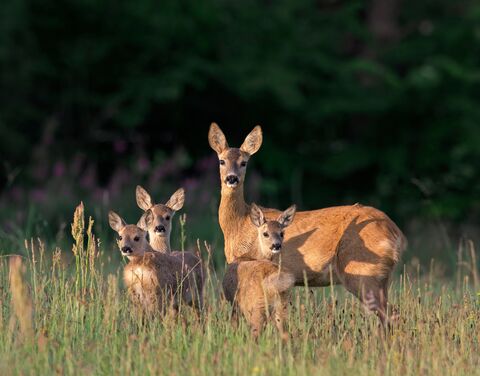
In the fall, the risk of a wildlife vehicle collision rises. Particular caution is called for in the cantons of Jura, Fribourg, and Thurgau. Across Switzerland, wildlife vehicle collisions cause over CHF 50 million in claim costs every year. Drivers should mind the warning signs, adjust their speed, and be prepared to brake. If you hit a wild animal, you must report this to the police immediately; otherwise you risk being prosecuted for animal cruelty.
Thousands of wild animals die on the roads every year. The darkest time of year and thus the season with the worst visibility in the morning and evening hours increases the risk of colliding with a wild animal. More than 3,000 wildlife vehicle collisions are reported every year just to AXA, Switzerland’s largest motor vehicle insurer. The amount paid out in claims is more than CHF 10 million every year, rising to more than CHF 50 million for Switzerland as a whole.
AXA’s claims statistics show that the likelihood of colliding with an animal differs from region to region in Switzerland. Car drivers should be particularly careful in Jura, Fribourg, and Thurgau, where the risk is up to seven times higher than in other cantons. In Geneva and Nidwalden, the risk of a wildlife vehicle collision is the lowest in Switzerland.
Wildlife vehicle collisions can essentially happen at any time of day and in any season. “However, drivers should be especially careful in October, November, and December because, as the days get shorter, wild animals are more likely to be out and about at the same time as car drivers. It’s also dark in the morning and evening, so drivers often don’t see animals on the road until it’s too late,” explains Luca Genovese, Head of Research & Prevention and head of AXA Mobility Competence Center. “Drivers should therefore adjust their speed and be ready to brake at any time in the morning or evening – particularly in wooded areas and where there are warning signs,” he advises. If a wild animal does suddenly leap out in front of your car, it is better to brake hard than to try avoiding it.
«When the days become shorter, it is more likely that wild animals will be out and about at the same time as car drivers.»
If you do hit a wild animal, you are required by law to notify the police immediately. The police will then call in a gamekeeper, hunter, or other specialist to put it out of its misery if necessary.
“Anyone who doesn’t report an accident to the police immediately or only does so at the insurance company’s request is liable to be prosecuted for animal cruelty,” says AXA-ARAG legal expert Fabrizio Howald. There has been a trend toward applying the law more strictly in the past few years: While people used to be fined simply for violation of duty, these days they may be prosecuted for negligent or even deliberate animal cruelty. “If you don’t immediately report an accident with a wild animal, the animal may suffer needlessly for hours. That would be a breach of the Animal Welfare Act, potentially resulting in prosecution for animal cruelty and a criminal record. In other words, we are not talking about a trivial offense,” adds the legal expert.